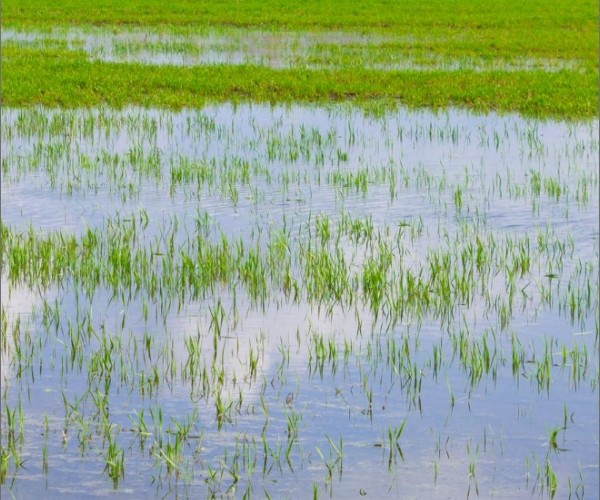- Turf
- Artificial
- Soil
- Timber
- Composite Decking
- Paving & Stone
Get In Touch With Our Experts Today!
Give us a Call! - Seed & Fertiliser
- Dressing
- Bark

February 23, 2022 Turf Tips
It’s heartbreaking to see the turf you’ve invested time and money in turn into a complete muddy mess! Sometimes, you don’t even know you have turf drainage issues until it’s too late. Thankfully, there are ways to fix a waterlogged lawn, improve lawn drainage, and restore your waterlogged turf to a vibrant and healthy state.
Working with some of the best turf-growing farms in the UK, we’ve pooled together our expert advice to help landscapers and homeowners keep their lawns in tip-top condition. Keep reading to learn the signs and causes of waterlogged turf, tips for avoiding a waterlogged lawn and garden water drainage tips.
In this blog, you’ll find out:
Have you ever walked across your lawn and felt that soft, sticky earth underneath? Or perhaps you’ve noticed parts or all of your grass collecting pools of water that don’t drain away. These are both signs of a waterlogged lawn. And they can be a landscaper’s nightmare – especially halfway through a turfing project!
Turf waterlogging usually occurs when dense or compacted soil experiences long periods of heavy rain. This type of soil struggles to drain the extra water away, meaning it sits on the surface of your lawn, creating a wet and muddy garden.
Yes, water is great for your grass, but if the soil beneath is not prepared to absorb heavy downpours, it can lead to time-consuming and potentially costly issues such as:
The first step is to monitor your turf and look out for symptoms of a soggy lawn, including:
If you spot any of these signs, it’s important to resolve the issue straight away to avoid further issues down the line.
Along with the wet weather (which can be fairly persistent in the UK!), many factors can contribute to a waterlogged lawn. The four main culprits are:
Healthy turf needs healthy soil to build a deep root structure, providing key nutrients and water for your grass to grow. If the soil beneath your turf has not been prepared properly or contains poor soil, it will struggle to absorb water and eventually kill your grass.
Even good-quality soil can become compacted over time due to footfall or vehicle traffic. It’s also quite common with heavier soils such as clay or loam. When soil becomes compacted, it reduces airspace and water drainage. Spending time aerating these areas will massively improve lawn drainage.
Regular sunlight will naturally dry up damp patches and help moisture evaporate from waterlogged areas. But not every garden is blessed with sunlight, and surface water can remain. For these types of gardens, invest in shade-tolerant turf, which thrives better in shadier spots and cut back any trees or hedges that stop the sun from shining through.
Clay soil can become waterlogged because, as heavier soil, it’s prone to compaction, preventing water from draining. Uneven lawns can also struggle with draining excess water, and piping may be required to draw water away from the waterlogged area.
Many people ask us, “Does waterlogged grass grow back?” The good news is, yes, it does! As we said, thankfully, there are lots of ways to prevent and fix waterlogged lawns. Once most of the water has evaporated, try some of our suggestions below:
Turf with a high level of fescue grass seed is a fantastic option for gardens prone to waterlogging. Fescue is one of the most resilient grass seeds – it quickly repairs itself during extreme conditions, helping reduce the risk of lawn disease and encouraging continuous strong, healthy grass growth.
Some of the quickest and most effective lawn drainage solutions include:
The George Davies team are on hand to help with your turf queries. If you need help solving your waterlogged lawn or want to refresh your turf, get in touch today. For landscapers, check out our George Davies Trade Account to aid with future orders.
How to Prepare Your Soil for Turf